MEASUREMENT ERROR ANALYSIS AND ADVANCED STATISTICAL METHODS
The supplemental features of measurement error analyses that are described in this section use graphical and simple mathematical manipulations of data. The techniques are based on statistical procedures that are part of high-level inferential statistics.
Individuals who are familiar with analysis of variance with repeated measurements (repeated-measures ANOVA), profile analysis, multivariate analysis of variance (MANOVA), and tests of compound symmetry may use these techniques to expand their analysis of the data. These techniques may be used to design very efficient and sophisticated experiments that study measurement error. The advanced procedures are beyond the scope of this chapter and should be attempted only if the analyst has performed the procedures of the basic methodologies and has unanswered questions concerning the sources of measurement system error. Professional statisticians use commercially available software packages (SAS, BMDP, MINITAB, or SPSS) and mainframe computer systems when they perform these analyses.
DATA COLLECTION PROCEDURES
-
Select five parts from the manufacturing process. The parts should be selected from the process so that they represent parts measured during the regular manufacturing process. The findings of the study should apply to the full operating spectrum of the manufacturing process. The parts may be randomly selected from the process stream, or they may be specified. So that the full operating range of the instrument is studied, some of the parts should be on the low side of the product specification, some should be near the center of the product specification, and some should be near the high side of product specification. A broad and plausible range of part sizes is needed if the linearity of the measurement system error is to be assessed.
-
Identify each part with a part number. The parts or test specimens should be prepared for measurement as is typical during the manufacturing process, for instance, burrs should be removed, chips and cutting oil should be wiped off, etc. The part numbers should be readily identifiable by the study analyst but not by the appraisers. The part numbers should be permanent and should be placed in such a way that they do not interfere with the performance of the measurement system.
Store the parts or test specimens in a protective manner between the measurement trials. Some measurement stability studies are conducted over very long periods of time. The test parts should be protected from chips, scratches, surface erosion , oxidation, or any other change that would interfere with measuring the characteristic.
-
Calibrate the measurement instrument. Calibrate the measurement device before measuring parts. Use a standard calibration procedure. If a standard calibration procedure does not exist, develop one and include it as part of the measurement system.
-
Determine the frequency of repeated measurements. The five standard parts should be retested at a frequency based on a regular and rational plan. Use an equal time period between the measurement trials. Select the time period between trials so that sources of special and common variation have an opportunity to be included in the study data.
-
Record the readings on a control chart form. Record the measurements carefully on a variables data control chart form. The data placed in one row must be measurements for one part. The data in Row 1 must always result from the part numbered 1, the data in Row 2 must come from only Part 2, and so on. Sample data are presented in Figure 15.17.
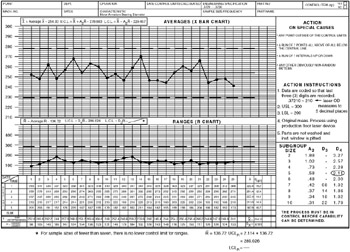
Figure 15.17: Sample coded data recorded on a control chart.
DATA ANALYSIS
Two analyses are made of the data collected during measurement stability studies. One evaluates the stability of the measurement process; the other describes the magnitude of measurement error.
All measuring systems (regardless of the magnitude of measurement error) should be a stable system of error. The mean and range across the five standard parts ( n = 5; calculated down the columns of Figure 15.17) are used for this analysis. These values include a combination of differences between the five parts and measurement error. If the measurement system is completely repeatable, the time series plot of these means and ranges will yield a flat line with no variation. The ranges will be plotted directly on top of the Rbar line. The Rbar line represents the range between the five standard parts. Deviations away from the Rbar line indicate measurement error.
The means (Xbars) across the five parts should also be plotted directly on top of the Xdouble bar line. The Xdouble bar line represents the average of the five standard parts. Differences between the Xbar center line and individual Xbars show the degree of measurement error. Because the same five parts are measured repeatedly, the plotted data should be very close to the chart center line. In fact, the more unusual the variation appears to be around the center lines, the more repeatable the measuring system is. For this reason, the limits used for the Xbar chart are modified from those used on regular control charts . The plotted data should not show any extreme points or any time- related signals. All of the plotted data should be within the chart limits and should not demonstrate any significant run, trend, or cycle.
The capability level of the measurement system can be evaluated only if the measurement process is stable. Assess measurement system capability by comparing the size of the measurement error distribution with the product tolerances. This analysis is summarized by the P/T ratio. The variations contained within the repeated measurements of each standard part ( n = 25; calculated across the rows of Figure 15.17) result only from measurement repeatability. Calculate a variance estimate (squared standard deviation) for each of the standard parts. These estimates include only repeatability error and would equal zero for a perfect measurement system. Average the five estimates into a single estimate of the standard deviation for repeatability error. This standard deviation is used to calculate a P/T ratio.
-
Calculate summary statistics for each measurement trial. Calculate a mean (Xbar) and range ( R ) for each of the measurement trials. These statistics are calculated for each of the columns of data in Figure 15.17. The range of each measurement trial estimates the range for the five parts. The mean of each trial estimates the mean for the five standard parts. If the measurement process were completely repeatable, each of the measurement trials would result in exactly the same range and mean.
-
Calculate center lines for the summary statistics. The mean range (Rbar) and the mean of the means (Xdouble bar) serve as the center lines of the two control charts. All of the plotted data would be placed directly on top of these lines if the measurement system were completely repeatable. Deviations from the chart center lines show the error that is due to repeatability. Use the formula below to calculate the chart center lines:
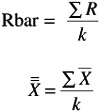
where
| & pound ; R | = | sum of the ranges |
| | = | sum of means |
| k | = | number of measurement trials |
Below are the calculations used to construct the charts in Figure 15.17:
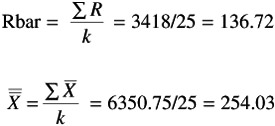
-
Calculate limits for the summary statistics. Because the same five standard parts were measured repeatedly, the plotted data are not independent and should look "unusual." More than two thirds of the plotted data points should be close to the chart center lines. The control limits for the range chart are calculated using the standard formulas.

where
| D 4 , D 3 | = | factors based on the sample size |
| | = | mean range |
Below are the calculations used to construct the charts in Figure 15.17:
| UCL R | = | D 4 — Rbar |
| = | 2.114 — 136.72 | |
| = | 289.026 | |
| LCL R | = | D 3 — Rbar |
| = | - x 136.72 | |
| = |
|
Modified control limits must be calculated for the Xbar chart because the Xbars include a combination of both part differences and repeatability error. Modified limits sensitive to extreme values are calculated by using the variation in the Xbars.

where
| | = | the centerline of the Xbar chart |
| | = | the standard deviation for the trial means |
Below are the calculations used to construct the charts in Figure 15.17:
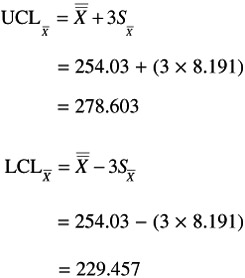
-
Plot the center lines, limits, and summary statistics on the control chart form. The Rbar value should be located about one third to one half of the distance from the bottom of the vertical scale of the R chart. The UCL R should be positioned approximately two thirds to three fourths of the distance up the scale. When the sample size is six or fewer, there is no lower control limit for the R chart.
The Xdouble-bar value should be located at about the center of the scale on the Xbar chart. Center the control limits around the Xdouble-bar value and space them about one half to two thirds of the distance between the X value and the ends of the chart scale.
Plot the Xbar and R values for each sample on their respective charts. Place the plotted points directly above the data and time sequence information included in the data table. The plotted points may be connected with a solid line to aid the analysis of patterns and trends in the data. Proofread the plotted points and compare them with the summary statistics; then draw the control limits and process averages on the charts and analyze the process for stability.
-
Interpret the summary statistics for unexpected signals. The ranges and means should be plotted very close to the process center lines. The more unusual the variation of the plotted data, the more repeatable the measurements system is. All of the plotted data should be within the chart limits and should not demonstrate any significant run, trend, or cycle.
-
Calculate summary statistics for each part. Calculate the mean, standard deviation, and variance for each of the five standard parts. The variance is equal to the squared standard deviation and is calculated with the formula below:

where
| X | = | an individual measurement |
| | = | the mean of all the measurements for the part |
| k | = | the number of repeated measurement trials |
The mean for each part is the single best estimate of that part's measured characteristic. The standard deviation and variance are estimates of measurement error due to repeatability. A measurement system that is completely repeatable would yield a standard deviation and variance due to a repeatability of zero.
-
Calculate the mean standard deviation for repeatability error. Average the repeatability variance for the five standard parts into a single estimate of variation for repeatability error. Use the formula below to calculate the mean standard deviation for repeatability:

where
| | = | mean standard deviation for repeatability error |
| | = | sum of variance estimates for all the parts |
| n | = | number of parts |
Below are the calculations used to construct the charts in Figure 15.17:
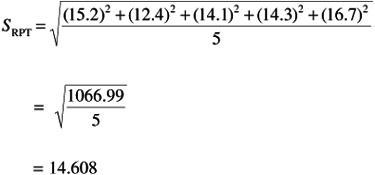
-
Assess the homogeneity of the repeatability variance estimates. The five estimates of repeatability variance should be estimates of the same repeatability distribution. There should be no significant difference between the five estimates of repeatability variation. This assumption can be tested by comparing the repeatability standard deviations with control limits. All of the standard deviations should be within the upper and lower control limits (UCL and LCL).

where
| B 4 , B 3 | = | factors for calculating control limits based on the sample size |
| | = | mean standard deviation for repeatability |
Below are the calculations used to construct the charts in Figure 15.17:
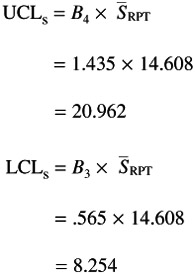
-
Assess the relationship between part size and measurement error. A measurement system should have the same degree of error for all part sizes. Evaluate the relationship between repeatability standard deviations and part means by making a scatter diagram of the part Xbars and standard deviations. Figure 15.18 shows a scatter diagram constructed for the data in Figure 15.17.
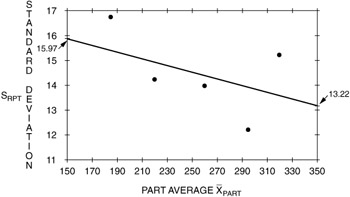
Figure 15.18: Scatter diagram for S RPT and part average Xbar PART .
The information from the scatter diagram may be reinforced by calculating a correlation coefficient between the part Xbars and standard deviations. This number should only be used to support the interpretation of the scatter diagram. Using only five parts, too few data points have great confidence in the correlation coefficient. The correlation coefficient is a unitless number that describes the strength and direction of a relationship. The correlation may range from -1 to +1. When no relationship exists between two variables, the correlation coefficient equals zero. Strong relationships are described by correlation coefficients that are closer to +1 or -1. A positive correlation coefficient results when one variable increases with another. Negative correlation describes an increase in one variable while the other decreases. Below are the formulas and calculations for the correlation coefficient of the data presented in Figure 15.17:

Table 15.1 displays the actual statistical calculations.
| Xbar | S | ( | S - Sbar | ( X - Xbar) 2 | (S - Sbar) 2 | (X - |
|---|---|---|---|---|---|---|
| 322.4 | 15.2 | 68.38 | .66 | 4675.8244 | .4356 | 45.1308 |
| 291.4 | 12.4 | 37.38 | -2.14 | 1397.2644 | 4.5796 | -79.9923 |
| 257.4 | 14.1 | 3.38 | -.44 | 11.4244 | .1936 | -1.4872 |
| 211.0 | 14.3 | -43.02 | -.24 | 1850.7204 | .0576 | 10.3248 |
| 187.9 | 16.7 | -66.12 | 2.16 | 43.71.8544 | 4.6656 | -142.8192 |
| SUM | ||||||
| 127.01 | 72.7 | 12,307.088 | 9.932 | -168.8431 | ||
| Average | ||||||
| 254.02 | 14.54 |
The calculated correlation coefficient equals -0.4829. This is a weak negative relationship. Higher levels of repeatability error were observed for small-diameter parts. Considering the small sample size, this relationship is too weak to call for action or additional investigation.
-
Estimate the population standard deviation for repeatability error. Convert the mean standard deviation for repeatability into an unbiased estimate by dividing by a constant value (C 4 ). Use the formula below:

where
| | = | mean standard deviation for repeatability |
| C 4 | = | constant values based on the sample size |
Below are the calculations used to construct the charts in Figure 15.17:

= 14.608/.9896
= 14.762
-
Calculate the product/tolerance ratio. Error due to measurement system repeatability is evaluated by comparing the estimate for repeatability error with the product tolerance. Calculate the percentage of the tolerance used by measurement system error using the following:

where
| RPT | = | population standard deviation for repeatability error |
| tolerance | = | upper specification limit minus lower specification limit (USL - LSL) |
Below are the calculations used for determining the P/T ratio for Figure 15.17:
| P/T ratio | = | 6 |
| = | 6 — 14.762/300 - 200 | |
| = | 0.886 |
ANALYSIS OF VARIANCE
The measurement analysis may also be conducted with an analysis of variance (ANOVA). It is beyond the scope of this volume to discuss ANOVA in detail (see Volume V of this series); however, when ANOVA is used for measurement analysis the following must be understood :



A typical representation of an ANOVA table is shown in Table 15.2.
| Source | DF | SS | MS | EMS | F |
|---|---|---|---|---|---|
| Appraiser | k - 1 | SS o | SS o / k - 1 = MS o | 2 + r ³ 2 + nr ‰ 2 | |
| Parts | n - 1 | SS p | SS p / n - 1 = MS p | 2 + r ³ 2 + kr ƒ 2 | |
| Appraiser — Parts | ( n - 1)( k - 1) | SS op | SS op /( n - 1)( k - 1) = MS op | 2 + ³ 2 | |
| Gage(error) | nk ( r - 1) | SS e | SS e / nk ( r - 1) = MS e | 2 | |
| Total | Nkr - 1 | TSS | Appraiser ~N ( o , ‰ ) 2 Parts ~ N ( o , ƒ 2 ) Appraiser — Part ~ N ( o , ³ 2 ) Gage(error) ~ N ( o , 2 ) |
where
| Gage 2 | = | MS e |
| Interaction ³ 2 | = | (MS op - MS e )/ r |
| Appraiser ‰ 2 | = | (MS o - MS op )/ r |
| Part ƒ 2 | = | (MS p - MS op )/ kr |
| Equipment Variation (EV) | = | 5.15(MS e ) 1/2 |
| Appraiser Variation (AV) | = | 5.15 [(MS o - MS op )/ nr ] 1/2 |
| Interaction part — Appraiser (I) | = | 5.15 [(MS op - MS e )/ r ] 1/2 |
| R&R | = | [(EV) 2 + (AV) 2 + (I) 2 ] 1/2 |
| Part variation (PV) | = | 5.15 [(MS p - MS op )/ kr ] 1/2 |
In the additive model, the interaction is not significant, and the variance components for each source are pooled. To check for significance, check the F statistic in the ANOVA table.
Equipment Variation (EV) = 5.15(MS pool ) 1/2
Appraiser Variation (AV) = 5.15 [(MS o - MS pool )/nr] 1/2
R&R = [(EV) 2 + (AV) 2 ] 1/2
Part variation (PV) = 5.15 [(MS p - MS pool )/ kr ] 1/2
INTERPRETATION OF MEASUREMENT ERROR FINDINGS
Measurement error studies are conducted as a means of quantifying and evaluating the magnitude of measurement system error. The percentage of the product tolerance used by measurement system error is calculated during Step 20 of the basic measurement error study. This value compares the spread of error inherent to the measurement system with the product tolerance. The variation due to the measurement system should be smaller than the product tolerances. The following decision rules are usually used to evaluate the magnitude of measurement error:
-
Measurement system error less than 10% of the product tolerance is an acceptable level of measurement error.
-
Measurement system error between 10 and 30% of the product tolerances may be considered acceptable depending on the importance of the measured characteristic, cost of incorrect machine adjustment decision, cost of the gauge, or cost and/or time needed for gauge repairs .
-
Measurement system error greater than 30% of the product tolerance means that the measurement system should be considered unacceptable, and every effort should be made to reduce the level of measurement error.
If the percentage of the product tolerance used by measurement system error is less than 10%, the study of the measurement system should be continued to provide further insight to the nature of measurement error. The basic measurement error study is only a one-point-in-time study. It is a good screening study to identify poor measuring systems, but it does not provide information concerning the stability of the measuring system. The study should be extended so that additional measurement trials are made. Additional trials are needed for the assessment of the measurement system stability.
Measurement systems that yield unacceptable levels of measurement error must be diagnosed and improved. If the percentage of the product tolerance is unacceptably large for the basic measurement error study, the system will demonstrate even greater levels of error over a longer period of time.
EAN: 2147483647
Pages: 181